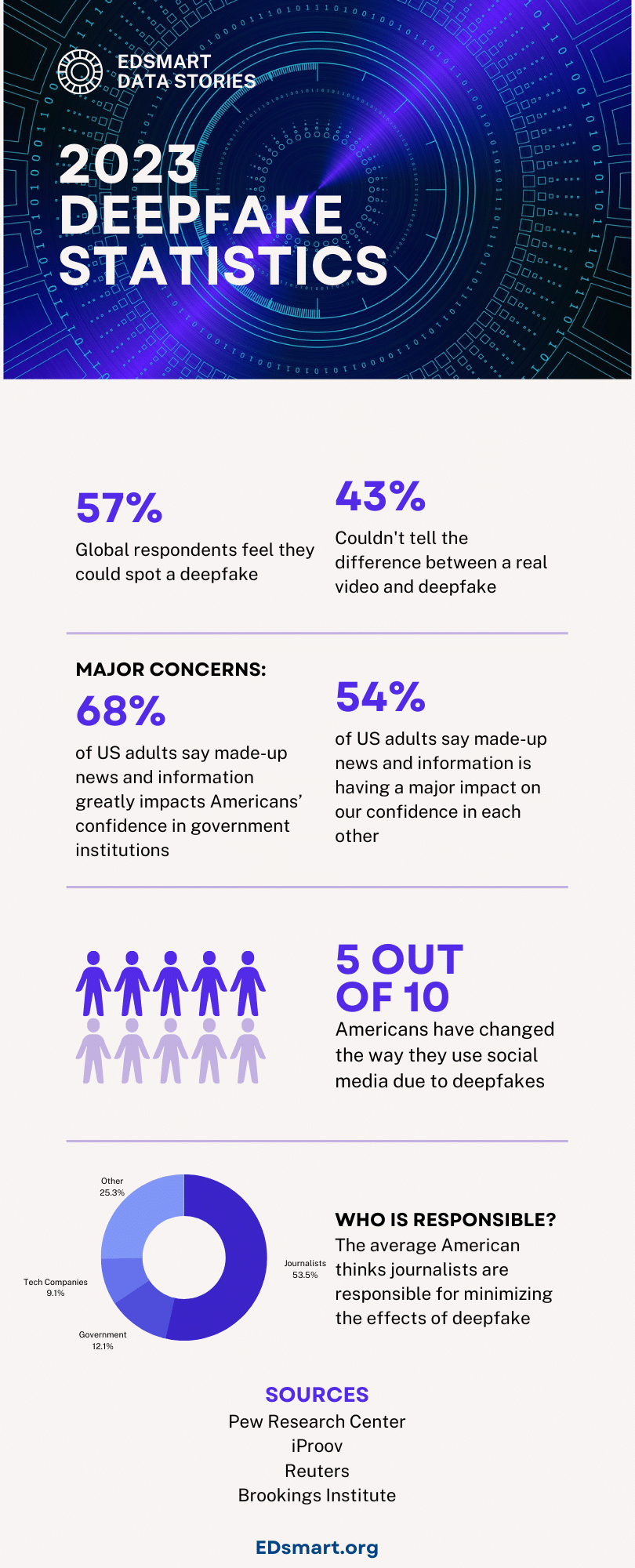Deepfake Crime by the Numbers
In 2023, about 500,000 video and voice deepfakes will be shared on social media around the world, according to DeepMedia (Reuters). As advancements in technology continue to reshape our digital landscape, the rise of deepfake crime has become a significant concern.
By understanding the scope and nature of deepfake-related offenses, we can better equip ourselves to tackle this growing challenge and safeguard the authenticity and integrity of our digital world.
What is deepfake?
Deepfake refers to the technique of manipulating multimedia content, typically videos, using artificial intelligence and machine learning algorithms. Deepfake creators tamper with existing footage or images to superimpose or replace original subjects with alternative faces or bodies.
Deepfakes leverage neural networks to generate realistic visual and auditory elements to create deceptive and misleading content. It can be employed to fabricate false information, spread misinformation and deceive masses of unsuspecting viewers.
- The number of deepfake videos on the internet has doubled since 2018, reaching 14,678 videos in 2021 (Deeptrace)
- Deepfake technology is becoming more sophisticated, with an 84% increase in deepfake creation models from 2019 to 2020. (Source: CSO Online)
Recognizing Deepfakes
- Globally, 71% of respondents say that they do not know what a deepfake is. Just under a third of global consumers say they are aware of deepfakes (iProov)
- 57% of global respondents say they think they could spot a deepfake (iProov)
- 43% admit they wouldn't be able to tell the difference between a real video and deepfake (iProov)
- 53% are confident in their ability to recognize altered videos and images (Pew)
- 61% say it is too much to ask of the average American to be able to recognize altered videos and images (Pew)
- 38% say the public should be able to recognize altered videos and images (Pew)
- 53% of Americans say it is easy for them to recognize this type of altered content when they come across it (Pew)
- 46% say it’s hard for them to recognize altered content (Pew)
- Over 95% of all deepfake videos are created using DeepFaceLab. (Gemini Advisory)
What do Americans think?
- 77% of Americans say steps should be taken to restrict altered videos and images that are intended to mislead (Pew)
- 22% of Americans want to protect the freedom to publish and access videos and images that are intended to mislead (Pew)
- 50% of people fear that deepfakes could be used for “theft of my identity to access my bank and other accounts” (iProov)
- 48% of people fear “being led to believe something that isn’t true” and “theft of my identity to set up credit cards or bank accounts in my name” (iProov)
- 13% of global respondents are unconcerned by deepfakes (iProov)
What impact is it having on everyday Americans?
- In North America, the proportion of deepfakes more than doubled from 2022 to Q1 2023. This proportion jumped from 0.2% to 2.6% in the U.S. (Business Wire)
- 52% of Americans have changed the way they use social media (Pew)
- 43% have lessened their overall news intake (Pew)
- 15% of Americans encounter altered videos or images often (Pew)
- 33% of Americans say they hardly ever or never come across altered videos or images (Pew)
- 66% of Americans say they at least sometimes come across altered videos and images that are intended to mislead (Pew)
- 63% say videos and images altered to mislead the public cause a great deal of confusion (Pew)
- Deepfakes are becoming more common in financial scams, with a 300% increase in deepfake-based fraud attempts reported in 2020. (Source: Digital Guardian)
How does Deepfake affect America's political atmosphere?
- 68% of US adults say made-up news and information greatly impacts Americans’ confidence in government institutions (Pew)
- 54% of US adults say made-up news and information is having a major impact on our confidence in each other (Pew)
- 73% see a lot of made-up news and information being generated around two major topics: politics and elections (Pew)
- 63% of Americans say made-up or altered videos and images create a great deal of confusion about the facts of current issues and events (Pew)
- 77% of both Republicans and Republican-leaning independents and Democrats and Democratic leaners favor restrictions on altered videos over protecting the freedom to publish and access them (Pew)
Who's responsible for solving this problem?
- 53% of Americans believe journalists have the greatest responsibility to reduce made-up news (Pew)
- 12% say the responsibility falls on the government (Pew)
- 9% say tech companies are responsible (Pew)






